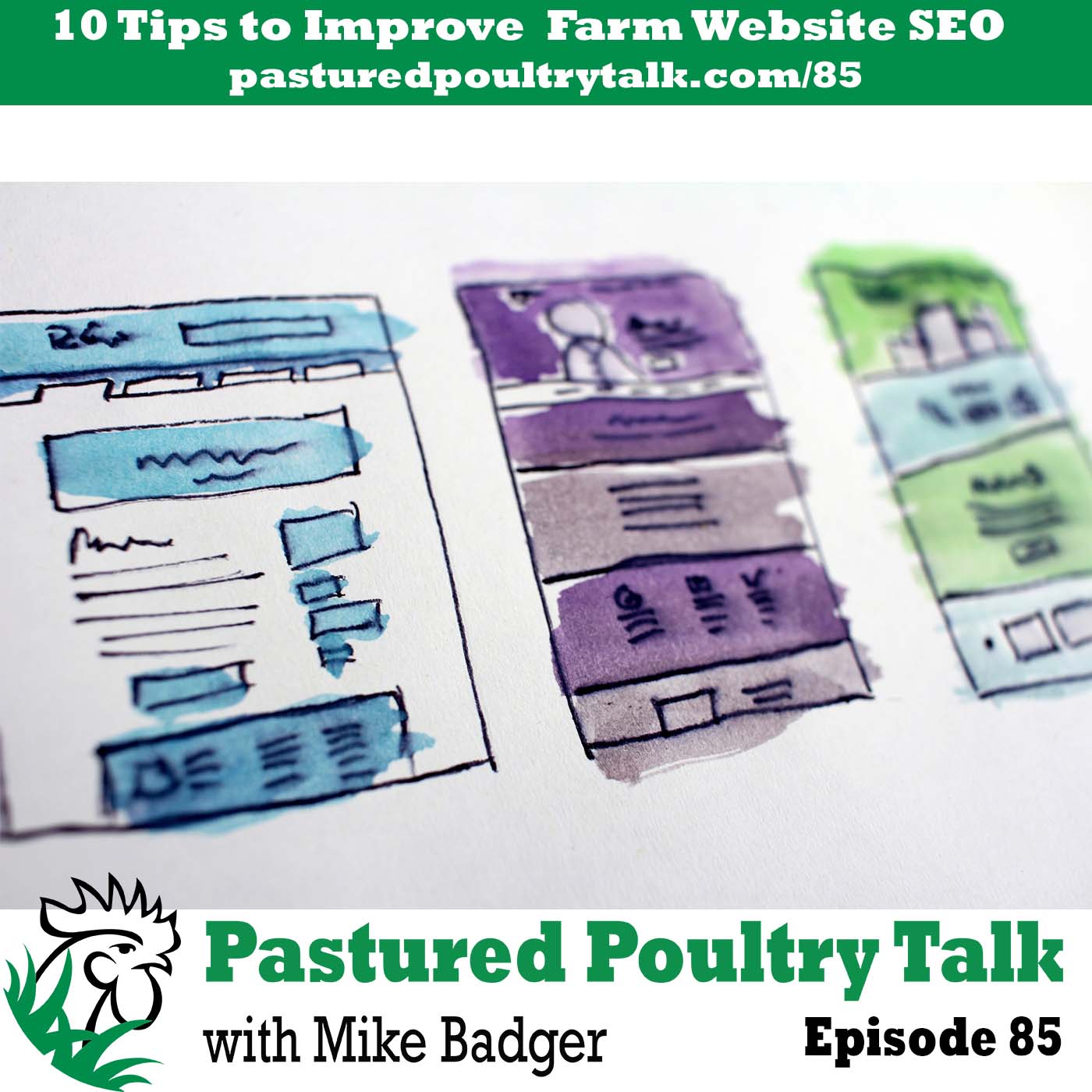
[podcast src=”https://html5-player.libsyn.com/embed/episode/id/9552023/height/90/theme/custom/thumbnail/yes/direction/forward/render-playlist/no/custom-color/88AA3C/” height=”90″ width=”100%” placement=”top” theme=”custom”]
In this episode I discuss the foundation principles required to improve farm website SEO (search engine optimization). Farm website SEO helps you be found by people who are looking for the products and services you sell; that’s why it’s a critically important foundation for your entire marketing program. The only thing worse than not having a website in 2019 is having a website that doesn’t work for your business.
Over the last year, there have been an increasing number of instances that have made me want to pull my hair out when I heard the “advice” some people give in terms of websites and their role in marketing. I also see a lot of questions popping up about websites in the Pastured Poultry Talk Facebook group and other places.
I realized that I can contribute to the conversation even though I’m not known as an SEO consultant to small farms, I’ve been implementing SEO for over a decade, and half of that time was coaching small businesses through the creation and implementation of their own marketing strategies using website SEO as the starting point. I worked as an Account Manager for one of Pennsylvania’s premiere marketing agencies, MoJo Active. Even though I left MoJo Active, I never stopped optimizing and managing websites.
Not everyone will like the advice I lay out in this episode. There’s no magic formula for farm website SEO. I’ll give you 10 key ways to optimize your site, but you have to put the ideas into practice. This is where many people falter.
Here’s what I know. Your return will be proportionate to the effort you put into your farm website SEO. That means you need to do it, learn about, hire somebody, or simply make an investment in your farm website. The work you do with SEO today will pay dividends for months and years to come through discovery in the search engines.
The challenge you’ll have is that the payback on your investment will not be immediate; there’s a time delay. This is the trap SEO sets for you in your business. Farm website SEO is a good off-season project and should be incorporated into your regular marketing time.
When you counter the long-tail advantage of search traffic with the instant gratification of Facebook ads or sponsored posts, and you have a good combination approach to marketing; however, with social media, your posts are relevant now and not findable tomorrow, and that’s one reason you always invest in your website.
 Do you need a helpful guide to coach you through the implementation of these strategies on your website in the context of your farm business? Hire Mike for a one hour coaching call ($50) and get on the right track.
Do you need a helpful guide to coach you through the implementation of these strategies on your website in the context of your farm business? Hire Mike for a one hour coaching call ($50) and get on the right track.
Your Farm Website SEO Does These 4 Jobs
When I think about your website’s role in your business, I typically talk in these four broad areas:
- Support/information
- Marketing and sales
- Customer discovery
- Lead generation
As you build a website to support your farm business and then market those products, the website will attract people who didn’t know about you. This is the secret to farm website SEO. It’s the key to being found on the web.When people who didn’t know about you land on your website, they may purchase a product or sign up for your email notifications.
When talking about the lead generating power of a website, I think it’s important to consider people’s habits and purpose for using various mediums. Facebook is a casual environment for people to be idle and engage in chatter. When people have problems to solve, they may ask their friends on Facebook for advice, but most likely, they search Google. Even friends on Facebook will often respond with a website link.
#1 Install Email Capture
Even if you have no intention of using email marketing. Set it up and do it first. That’s how important it is. When you finally get ready to believe that email is important, you’ll be thankful you were collecting emails from the beginning.
We’ll dig into email marketing in episode 86 of Pastured Poultry Talk.
#2 Install Google Analytics
Like email, Google Analytics is not about actual website content optimization, but it is a necessary tool and a prerequisite to managing your site. Analytics shows you visitor and usage data as it relates to your farm website pages. Install the search console and dive into a keyword rich understanding.
Even if the thought of looking at a report seems intimidating, install Google Analytics from day 1. When you’re ready to interpret the data, you’ll be thankful. Or better yet, when you work with someone like me and they ask for the Google Analytics reports to help you measure your farm website’s performance, they’ll be thankful.
#3 Create a Site (Content) Map to Optimize Website Farm SEO
 The site content map will help you think through the navigation of your website and document what pages you to need to create. It will also help you visualize your customer’s path through the website. Ask yourself, if a visitor comes to the home page, where should that person click next? And if the person comes in through a backdoor (like a blog post), is the path through the website clear? Is the next click evident?
The site content map will help you think through the navigation of your website and document what pages you to need to create. It will also help you visualize your customer’s path through the website. Ask yourself, if a visitor comes to the home page, where should that person click next? And if the person comes in through a backdoor (like a blog post), is the path through the website clear? Is the next click evident?
I go so far as to sketch out how I want my pages and posts to look by visualizing image placement (align right or left or full width hero image).
When you write individual pages, you just follow your format and create images that fit your intended format, so you don’t have to put a lot of thinking into it. Also, when you’re writing individual pages, use headings and bullets to create a scannable page with a clear progression.
Look at the page you’re reading. It has many headings. I’m telling you (and Google) what’s important by emphasizing the context of the of the page. As a result, I’m improving SEO by creating useful content that is relevant to my visitors.
Creating the content map is about establishing a structured website in terms of navigation, hierarchy, and page content. Think about a book. A book has a TOC (your website menu). It has chapter headings to group closely related content. Depending on the type of book, each chapter may have sub headings, lists, images, charts, quotes, or dialogue that gives you a clear understanding of the content and provides an easy way to consume the content.
If you put time into creating a structured website with a deliberate organization throughout and you write content that addresses your customers, needs, wants, fears, desires, and hopes in language they can relate to, you’ve just taken a big bite of SEO for your farm website.
#4 Identify Call to Actions
A call to action on your website guides a visitor to the next click. It lets them know the expected action. As yourself this. “Why would I spend so much effort on website SEO and not lead visitors through my desired outcomes?”
Example call- to-actions might be call now, sign up for email, buy now, and so on.
Every page on the website needs a call to action. And one of the best pieces of selling advice I ever received was to “ask for the sale, every time.” Don’t assume the other person knows what you want. The other person may say no, or they may leave your website. That’s ok. But they might buy because you asked and that’s great.
#5 Tell the visitor how to buy
You probably have several sales channels that you use to sell products. One of the challenges consumers have with buying local food is the barrier to buying the good food you produce because every farm is different. State how to buy clearly and list all your markets, restaurants, locations, store hours, and procedures.
If you build a page that has a list of all the ways you can buy, that will serve as a landing page that will guide people to a page for each way to buy. See #6 for information about local SEO and #7 for landing pages.
#6 Build local SEO into your farm website
As a local farm, you’re trying to attract customers near you. Local farm website SEO can be a complicated thing to wrestle, and often will extend beyond your website. However, your website must serve as the authoritative base.
The examples I use in the podcast include creating one page for each of your delivery drop-off locations. The other example is to list all the restaurants (with their locations) and possibly create a page for each restaurant that showcases the food and chef at that location.
The only way Google or any search engine knows that you sell food in your community is by you providing that context on your website through real words and content.
#7 Create landing pages to enhance website SEO
 Landing pages group multiple pages of similar content together. They are like funnels in that a person views the landing page, reads some information, and then selects a specific page to visit. The flow of information is broad to specific.
Landing pages group multiple pages of similar content together. They are like funnels in that a person views the landing page, reads some information, and then selects a specific page to visit. The flow of information is broad to specific.
In the podcast, I gave two example uses for landing pages to optimize your farm website SEO. In the first example, you might create a category page in your store for pastured poultry that tells your story and then links to the product pages for your chicken sausage, wings, whole birds, etc.
In the other example, I created a landing page for the delivery service your farm might run. You’d include information about the service itself, maybe with links to the products you sell (or their categories) and then link to the page for each delivery location that I described in number six of the SEO updates for farm websites.
#8 Create a separate page for each product
Each product needs its own page on your website, preferably with a relevant image. You can have landing pages that guide visitors to those products, but ultimately, you want content pages that are singularly focused on a topic whether you’re talking about your drop-off locations or your chicken products.
The farm website SEO benefit is that people who are looking to buy chicken sausage can land on a page and know that you have their answer.
#9 Make your contact visible
I recommend you put your phone number in the header and your address in the footer. That way every page has the necessary information to contact you. When you view your website on mobile, the phone number will be at the top of the page, and often becomes clickable, making it easy for the person to reach out.
#10 Write Meaningful Content to enhance your SEO
You need to consider two qualities when evaluating meaningful content. The first is quantity and the second is content that solves the visitor’s need. Creating a structured website with clear calls-to-action helps the visitors find answers, and many of the items I present are about creating meaningful content. That lets us to address the quantity.
Regular product pages or blog posts should be at least 300 words. Landing pages and other cornerstone content pages should be closer to 800 or 900 words minimum. Don’t forget to write in a structured way, and use headings, bullets, and images. Throw in the occasional bold or italic for emphasis.
Resources
Topics by Timestamp
[09:39] Four jobs of your website
[14:13] Add email signup
[15:08] Add Google Analytics
[17:57] Create a content map
[27:34] Identify call-to-actions
[33:02] Tell me how to buy
[33:41] Build Local SEO farm pages
[38:16] Make contact visible
[42:11] Create one page for each farm product
[46:13] Create landing pages
[53:07] Write meaningful content

5 comments on “10 Tips to Improve Your Farm Website SEO – PPT085”